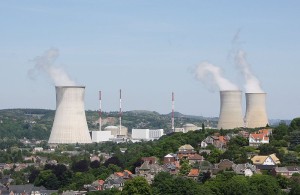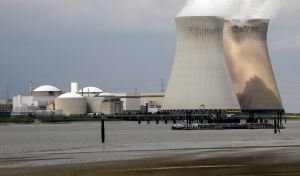nsnbc : Experts discovered new, additional cracks in reactor 2 at the Tihange nuclear power plant, located near the city of Liege, said Belgian Interior Minister Jan Jambon. The discovery of some 70 new cracks contradicts claims by some experts who said previously discovered cracks had been there since the reactor was built and irrelevant for the reactors operational safety. The reactor’s designed lifespan has been substantially extended despite warnings from experts and protests by neighboring communities in Belgium, the Netherlands and Germany.
Responding to an inquiry from the parliamentary group of Belgium’s Green Party, Interior Minister Jan Jambon admitted that experts discovered 70 more cracks in the pressure vessel of reactor two at the Tihange nuclear power plant (NPP) than during a previous inspection in 2014. However, Jambon claimed that the discovery of these additional cracks had no impact on the operational safety of the reactor at all.
Jambon stated that the additional 70 cracks had been discovered because the ultra-sound probes used to inspect the reactor vesselhad been placed at different locations than during inspections in 2014. Previously discovered cracks were no longer considered as damage or as posing a risk to operational security — The results of the latest inspection, in their entirety, prompted Belgium’s nuclear safety agency to state that it has no reason to oppose the operation of the reactor, said Interior Minister Jambon.
In 2015 Belgium’s Federal Nuclear Agency (FANC) registered a total of 3,149 reports about damages and incidents at reactor 2 at the Tihange NPP. This number had risen by 2.2 percent to 3,219 after the latest inspection, noted the NGO Nucléaire Stop. The NGO as well as experts from neighboring municipalities stress that it is no longer safe to operate the aging reactor.
Neighboring communities in Belgium, Germany and the Netherlands have long criticized the Belgian government for extending the life-span of the reactors at Tihange and Doel beyond their design limits. On June 25 concerned citizens and grassroots movements from Germany will travel to Tihange to create a human-chain around the Tihange NPP. Activists and critics have begun describing the Tihange NPP as “The Mummy”, stressing that a disaster that could force Belgium to build a Chernobyl-style “Sarcophagus” could happen any time.
Green Party (Ecolo) MP Jean-Marc Nollet, who had styled the questions about the reactor to Jambon stressed that it was disturbing that the Interior Minister had not, on his own volition, provided information about the number of cracks and the size of the cracks in the reactor vessel.
Moreover, reactor two is not the only one at Tihange that is causing gravest concerns. Reactor 1 was shut down in September 2016 and was scheduled for re-start in early 2017. The re-start of the reactor was originally scheduled for February 15 but was then delayed to February 28, 2016. According to latest information the restart has again been delayed until the end of March 2017.
An agreement on the additional delay was reportedly reached in cooperation between FANC and the Tihange NPP operator Engie Electrabel after the FANC found that Engie’s case for re-staring reactor 1 prior to additional tests have been completed wasn’t sufficiently strong. The Tihange Reactor 1 was shut down in September 2016 after Engie Elecrabel reported that damage was done during work at the site.
Engie Electrabel did at hat time not specify what damage was done but noted that the damage occurred in the non-nuclear part of the plant that hosts auxiliary pumps. In other words, in a part of the plant that is related to heat exchange and cooling, as in the case of the catastrophic incident at Fukushima in 2011. The reactor was shut down as a security precaution said Genie Electrabel. The company then added that the situation “is said to” have no consequences for the employees, local residents or the environment.
This “incident” was merely one of a cohort of incidents in the Belgian Doel and Tihange nuclear power plants. Incidents and safety concerns have grown so much that Dutch municipalities, in August 2016, went to the European Commission to demand the closure of the NPP at Doel.
The municipalities of Bergen op Zoom, Steenbergen and Tholen in the Netherlands took the issue about the troubled Doel Nuclear Power Pant (NPP) in Belgium to the European Commission. Bergen op Zoom Mayor Fran Petter stressed that taking the case to the European level brings us the greatest chance of success. The Doel NPP is located near the city of Antwerp, just across the Belgian border. The municipalities maintain that they have standing because they would also be affected if anything should go wrong at the Doel NPP.
Both the government of the Netherlands and the government of Germany have, over the past years, repeatedly stressed that they have lost any confidence in Belgian nuclear power plants, its operators and Belgian regulatory authorities after repeated problems at the NPPs in Doel and Tihange.
The Doel 1 and 2 reactors went on the grid in 1975 and were built with an expected lifetime of about 40 years. The Belgian government, however, extended their lifetime with 10 years to 2025, against stern opposition from neighboring EU member States and against a previous decision not to extend the license. he three Dutch communities also stress that they should have a say about the Doel 3 and 4 reactors which are slightly younger, but nonetheless also troubled by repeated problems which prompt grave concerns about their safety.
In 2014 the Belgian nuclear regulator ordered the reactors closed down after discovering indications of the above mentioned cracks in the core tanks of the 1,008 megawatt Tihange 2 and the 1,006 megawatt Doel 3 reactor. The decision was later reversed. Both the Doel and the Tihange nuclear facilities have had several incidents before that. The two reactors were restarted in May 2013, but were shut down again in March 2014 to allow for further tests and inspections, especially with regards to the integrity, strength and safety of the tanks.
Interim results of these inspections had shown that the tanks have been weakened to such a degree that it is necessary to keep the facility off the grid until the spring of 2015, and maybe, to take them off the grid altogether. In 2014 the Doel facility’s Doel 4 reactor was also taken off the grid due to an incident with one of its turbines.
The plants’ operator, Electrabel, insists that it is safe to keep the reactors online, also with their extended lifespan. Earlier in 2016 Belgium attracted international attention when the government started providing iodine pills to Belgian households, claiming it was not related to the risk posed by the reactors but to the potential risk that terrorists could use a “dirty bomb”.
The Belgian government has, in 2016, distributed iodine pills to the population “just in case something should happen” while claiming “the risk of terrorism” to be the main reason for concerns. Municipalities in the Netherlands as well as in the German federal state North-Rhine Westphalia also distributed iodine – while citing poor safety at Belgium’s NPPs as reason.
CH/L – nsnbc 11.06.2017
Source Article from https://nsnbc.me/2017/06/11/seventy-new-cracks-discovered-at-belgiums-ageing-tihange-nuclear-power-plant/
 RSS Feed
RSS Feed















 June 11th, 2017
June 11th, 2017  Awake Goy
Awake Goy 












 Posted in
Posted in  Tags:
Tags: 













